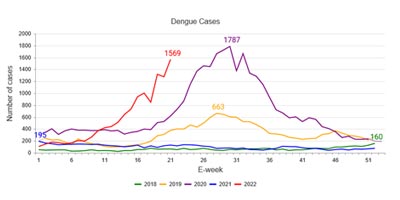What You Need to Know About Dengue Fever

Dengue fever is a mosquito-borne disease that occurs in tropical and subtropical areas of the world. The dengue virus is transmitted by the mosquito vector, Aedes aegypti, and is characterised by high fever, rash, and muscle and joint pains.
Apart from the dengue virus, the Aedes aegypti also transmits chikungunya, yellow fever, and Zika. It is a highly domesticated mosquito that lives in close association with humans and prefers to lay its eggs in water containers commonly found in and around homes. The National Environment Agency (NEA) had listed domestic and ornamental containers, and flower pot plates / trays among the top breeding habitats of Aedes aegypti in Singapore. The peak biting period is at dawn (two to three hours after daybreak) and dusk (several hours before dark).
There are four distinct, but closely-related strains (also known as serotypes) of the virus that cause dengue (DEN-1, DEN-2, DEN-3 and DEN-4). They are all present in Singapore.
Current Situation in Singapore
The number of dengue fever cases reported so far this year has exceeded the whole of 2021 and is already climbing towards the levels in 2020 when Singapore saw its worst dengue outbreak. There was one reported death due to dengue fever infection in May 2022.

Credit: Communicable Diseases Division, Ministry of Health
The cumulative number of cases for the first 21 weeks of 2022 stands at 11,673. The number of weekly reported dengue cases has been rising sharply, even before Singapore reaches the traditional peak dengue season from June to October.
There were1,569 dengue cases reported in the week ending 28 May 2022; 292 cases more than in the previous week. As of 30 May 2022, there are 398 active dengue clusters with 103 dengue clusters classified as a red zone (i.e. high-risk cluster with 10 or more cases). Dengue virus serotype 3 (DenV-3) has been detected at 67 of the 81 dengue clusters in the red zone. In April 2022, the Aedes aegypti mosquito population (the primary dengue vector) remained high in Singapore, and was about 22 per cent higher than in the same period last year (April 2021).
With the high Aedes aegypti mosquito population, together with circulation of the previously uncommon DenV-3, experts warn that the worst is yet to come with the traditional peak dengue season from June to October yet to arrive.
DenV-3 and DenV-4 are less common strains of dengue fever recorded in Singapore’s history, compared to the more dominant strains like DenV-1 and DenV-2. However, in 2021, Singapore saw the first DenV-3 outbreak in 40 years, and a four-fold spike in DenV-4 cases.
Dengue Symptoms and Illness Progression
Common symptoms of dengue infection include:
- Sudden onset of fever for two to seven days
- Severe headache with pain behind the eyes
- Joint and muscle pain
- Skin rashes
- Nausea and vomiting
- Mild bleeding (e.g. nose or gum bleed, or easy bruising of the skin)
Symptoms usually appear four to seven days after being bitten (ranges from three to 14 days). These symptoms can be very similar to other illnesses that cause fever, aches and pains, or rash. Up to 75 per cent of dengue infections do not present with symptoms.
Groups at Risk of Dengue-related Complications
Younger children and people who have not had the infection before tend to experience milder symptoms than older children and adults. People with weakened immune systems, as well as those with a second dengue infection are believed to be at greater risk of developing severe dengue infection.
Treatment
There is no curative treatment for dengue. Early supportive care with rehydration reduces risk of complications. In severe dengue, hospitalisation is needed for aggressive emergency treatment, including fluid and electrolyte replacement and/or blood transfusions.
Prevention of Dengue Fever
1. Dengue fever vaccination – The Health Sciences Authority (HSA) has approved the dengue fever vaccine, Dengvaxia, for the prevention of dengue infection caused by dengue virus serotypes 1, 2, 3, and 4 in individuals aged 12 to 45 years. The vaccination regime requires three doses to be administered over 12 months. Each dose is given at the 0, 6th and 12th month.
Benefits:
- Reduction in symptomatic dengue against all 4 strains – Vaccine efficacy of 81.9 per cent
- Reduction of severe dengue disease – Vaccine efficacy of 5 per cent
- Reduction in hospital admissions – Vaccine efficacy of 81.3 per cent
However, it is recommended that dengue vaccine be given to individuals who has had a dengue fever infection. Hence, a pre-vaccination dengue screening blood test or verifiable medical records showing positive results for dengue antibodies is necessary before receiving the vaccine.
Please contact your preferred Raffles Medical clinic for more enquiries on this vaccine or consider making the purchase online.
2. Stay in air-conditioned rooms with mosquito screens – The mosquitoes that carry the dengue viruses are most active from dawn to dusk, but they can also bite at night. Keep them out with wire-mesh mosquito screens and stay in air-conditioned rooms.
3. Wear protective clothing – When you go into mosquito-infested areas, wear light-coloured long-sleeved shirt, long pants, socks, and shoes.
4. Use mosquito repellent – Permethrin can be applied to your clothes, shoes, camping gear, and bed netting. You can also buy clothing made with permethrin already in it. For your skin, use a repellent containing at least 10 per cent concentration of DEET. Persons newly diagnosed with dengue should apply mosquito repellent regularly, so that mosquitoes do not bite and pick up the virus from them before biting someone else, thus reducing dengue transmission.

5. Reduce mosquito habitat – You can help reduce such breeding sites by eliminating habitats where they commonly lay their eggs. At least once a week, empty and clean containers that hold standing water, such as planting containers, animal dishes, and flower vases. Keep standing water containers covered between cleanings.
6. National effort using Wolbachia-infected mosquitoes – Singapore has been leading the way internationally in using Wolbachia-infected mosquitoes since 2016 in a suppression strategy. This is where male mosquitoes infected with the Wolbachia bacteria are released to mate but the resultant eggs cannot produce offspring, thus making the wild population crash. The data from the pilot field sites in Tampines and Yishun over the last few years suggest the approach is very successful in cutting mosquito populations there.


